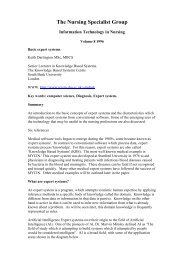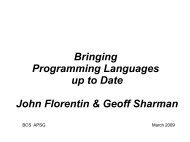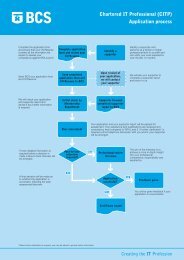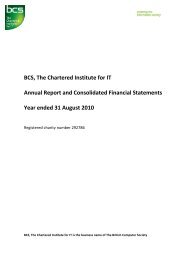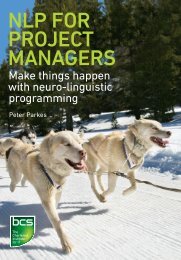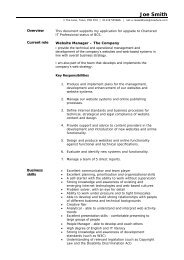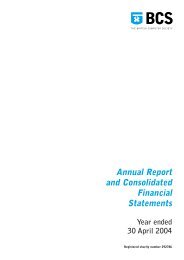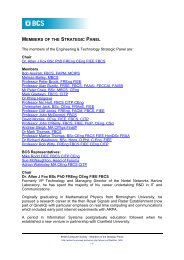SIREn: Entity Retrieval System for the Web of Data - BCS
SIREn: Entity Retrieval System for the Web of Data - BCS
SIREn: Entity Retrieval System for the Web of Data - BCS
- TAGS
- entity
- retrieval
- www.bcs.org
Create successful ePaper yourself
Turn your PDF publications into a flip-book with our unique Google optimized e-Paper software.
<strong>SIREn</strong>: <strong>Entity</strong> <strong>Retrieval</strong> <strong>System</strong> <strong>for</strong> <strong>the</strong> <strong>Web</strong> <strong>of</strong> <strong>Data</strong><br />
SPOC POCS OCSP CPSO CSPO OSPC<br />
(?,*,*,?) (?,p,*,?) (?,*,o,?) (?,*,*,c) (s,*,*,c) (s,*,o,?)<br />
p o c c/s s//o<br />
(s,*,*,?) (?,p,o,?) (?,*,o,c) (?,p,*,c) (s,p,*,c)<br />
s p/o c//o c//p c/s/p<br />
(s,p,*,?) (?,p,o,c) (s,*,o,c)<br />
s/p c//p/o c/s//o<br />
(s,p,o,?)<br />
s/p/o<br />
TABLE 1: Quad patterns covered by outgoing relations and <strong>the</strong>ir interpretation with <strong>the</strong> <strong>SIREn</strong><br />
operators. The ? stands <strong>for</strong> <strong>the</strong> elements that are retrieved and <strong>the</strong> * stands <strong>for</strong> a wildcard element.<br />
Q1 Q2 Q3 Q4 Q5 Q6 Q7 Q8<br />
Time (s) 0.75 1.3 1.4 0.5 1.5 1.6 4 0.35<br />
Hits 7552 9344 3.5M 57K 448 8.2M 20.7M 672<br />
TABLE 2: Querying time in seconds and number <strong>of</strong> hits <strong>for</strong> <strong>the</strong> 10 billion triples benchmark<br />
are also feasible. Intersection, union and difference between two or more quad patterns can be<br />
achieved efficiently using set manipulations over tree nodes.<br />
The covered quad patterns are a subset <strong>of</strong> <strong>the</strong> quad patterns covered by conventional RDF data<br />
management systems [6]. In fact, <strong>the</strong>y give <strong>the</strong> ability to retrieve in<strong>for</strong>mation about variables that are<br />
restricted to be at <strong>the</strong> subject, object or context position.<br />
It is important to underline however that we are restricting <strong>the</strong> search <strong>of</strong> an entity inside a dataset, i.e.<br />
<strong>SIREn</strong> does not allow <strong>the</strong> use <strong>of</strong> joins over different contexts, and <strong>the</strong> intersection <strong>of</strong> quad patterns<br />
within an entity, i.e. <strong>SIREn</strong> does not allow <strong>the</strong> use <strong>of</strong> chains <strong>of</strong> joins among multiples entities. This<br />
limits <strong>the</strong> query expressiveness to a star-shaped query, e.g. in Fig. 1b.<br />
2.3. Evaluation<br />
We finally report some per<strong>for</strong>mance and scalability benchmarks. Indexing time <strong>for</strong> a syn<strong>the</strong>tic<br />
dataset (120GB, 1 billion triples) took only 31 minutes while keeping constant time update and<br />
a relatively concise index (15GB) due to efficient compression using word-aligned binary codes. On<br />
a term-interleaved inverted index, we achieved a compression average <strong>of</strong> less than one byte per<br />
integer using Simple-9. Query time execution <strong>of</strong> various star-shaped queries per<strong>for</strong>med at <strong>the</strong> same<br />
order <strong>of</strong> magnitude than <strong>the</strong> state-<strong>of</strong>-<strong>the</strong>-art triple store RDF-3X [11].<br />
We evaluate <strong>SIREn</strong> scalability by indexing a dataset composed by 1 billion entities described in<br />
approximately 10 billion triples. The dataset is derived from <strong>the</strong> billion triple challenge dataset 7 . The<br />
machine that served <strong>for</strong> <strong>the</strong> experiment was equipped with 8GB ram, 2 quad core Intel processors<br />
running at 2.23 Ghz, 7200 RPM SATA disks, linux 2.6.24-19, Java Version 1.6.0.06 and GCC 4.2.4.<br />
The following benchmark was per<strong>for</strong>med with cold-cache by using <strong>the</strong> /proc/sys/vm/drop caches<br />
interface to flush <strong>the</strong> kernel cache and by reloading <strong>the</strong> application after each query to bypass <strong>the</strong><br />
application cache. The set <strong>of</strong> queries is provided at http://siren.sindice.com. The per<strong>for</strong>mance<br />
is given in <strong>the</strong> Table 2.<br />
3. CONCLUSION<br />
In this paper, we presented <strong>the</strong> current state <strong>of</strong> <strong>SIREn</strong>, an <strong>Entity</strong> <strong>Retrieval</strong> <strong>System</strong> <strong>for</strong> <strong>the</strong> <strong>Web</strong> <strong>of</strong><br />
<strong>Data</strong>. The main challenge that has been discussed in this paper is <strong>the</strong> design <strong>of</strong> an efficient inverted<br />
index especially designed <strong>for</strong> answering semi-structured (star-shaped) queries while preserving<br />
desirable IR features, such as web like scalability, incremental updates, top-k queries and efficient<br />
caching among o<strong>the</strong>rs.<br />
This work has been undergoing <strong>for</strong> approximately 18 months now and is at different stages <strong>of</strong><br />
experimentation, validation and ultimately deployment. For example, <strong>SIREn</strong> presented in this paper<br />
7 Semantic <strong>Web</strong> Challenge: http://challenge.semanticweb.org/<br />
The 3rd <strong>BCS</strong> IRSG Symposium on Future Directions in In<strong>for</strong>mation Access<br />
34




